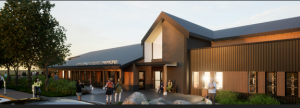Municipalities are the frontline in the battle for excellence in the built environment.
Even though funding from senior levels of government is often involved, the key decision-making responsibility for most public building projects rests within the broader municipal sector.
At the same time, governance of this sector is the closest to the people and potentially the most influenced by electors at the local level. Importantly, much of the reconstruction required of public infrastructure over the next 30 to 50 years will be implemented by the broader municipal sector, including the municipalities themselves.
The Government of Quebec recently adopted a Provincial Architecture Policy after several years of a broad public conversation about the value of architecture as a tool for improving the lives of people.
Interestingly, Quebec municipalities were much of the political impetus for the adoption of this policy. Very early, they recognized its potential for driving better outcomes for public building projects at a local level across the province.
Ontario can learn from Quebec’s experience and start down a path of establishing an architecture policy that will help us build better cities.
“Whereas a building code sets minimum standards, an Architecture Policy puts forward ambitious goals and calls to action. It describes how the built environment contributes to social, cultural, and economic well-being, and provides guidance to politicians, professionals, and the public on how to achieve more sustainable, just, and inspiring communities. An Architectural Policy empowers people to pursue positive change.”
Municipal building code officials are very aware of how prescriptive and performance-based building codes work; they recognize these codes establish only a minimum standard for a building’s technical design, performance and life safety.
Architects, however, reach for a higher standard. They strive to go beyond minimum building code requirements to achieve standards of excellence in the design of buildings. This excellence becomes “best practices.” But even the concept of best practices can be a constantly moving target, as the iterative work of architects in refining the design of buildings from one prototype to the next constantly moves the dial.
For the most part, architects feel this drive on behalf of the public interest — a genuine desire to leave the world a better place because of their work.
The Ontario Association of Architects (OAA) vision is of: “An Ontario in which architects are valued contributors to society, by creating a safe and healthy built environment that performs at the highest levels and elevates the human spirit.”
Such statements operate at the level of principle, setting out the highest aspirations for the work at hand.
An architecture policy expands on such aspirations, laying out in greater detail how these goals can be achieved and why society believes them to be important. It also outlines the roles and responsibilities of all the diverse players involved in the commissioning and designing of the built environment, showing how they work together to realize these high aspirations. It makes them each accountable for their part in this complicated symphony.
An architecture policy would serve as a guide for how projects in the built environment are procured and how design objectives are defined so that positive social outcomes can be supported and achieved.
Of course, making beautiful buildings is part of the equation, but there is so much more that should be achieved by public projects if they are to truly serve the people and communities for whom they are created and eloquently tell the stories of their cultural and physical contexts.
Unfortunately, the procurement of public built work often effectively closes the door on achieving the best value for society in these important public projects by shifting the focus to the very short-term goals of low cost and minimal risk.
The difference between competing fee proposals from design teams can represent a minute fraction of one per cent of the total life cycle cost of a building project. It is equally true that a small investment in additional fees can return 10 to 20-fold or more in increased value and lower operating costs over the anticipated 50-year life of a public building.
Competing for work where fees are a factor in winning serves only to drive fees down and limit the ability of architects and their design team to search for innovative design solutions that create real value in the built environment and achieve the higher purposes society expects from its public architecture. Such a creative search can be labour-intensive and it is certainly impossible to fully quantify the cost.
Adopting an architecture policy will focus the procurement process on a quality-based approach that values a design team’s qualifications and ideas, and bases compensation on established industry benchmarks.
It will help us all focus clearly on the high ambitions that public projects must achieve, empowering their designers to meet them.
An architecture policy holds both governments and design professions accountable for delivering building projects that are durable, socially and environmentally sustainable and beautiful, well-crafted expressions of who we are as a people and that are enduring public assets.
John Stephenson, OAA, FRAIC, is president of the OAA. One of the founding partners of FORM Architecture Engineering, the largest architectural practice in Northwestern Ontario, he most recently joined the OAA Council in 2013. Stephenson is passionate about promoting engagement on topics such as procurement, housing affordability, the creation of a national architecture policy and the role of the profession in reconciliation with Indigenous peoples. Send comments and Industry Perspectives column ideas to editor@dailycommercialnews.com.
Enjoyed reading this article? Check out the DesignX newsletter for more top headlines and subscribe.










Recent Comments